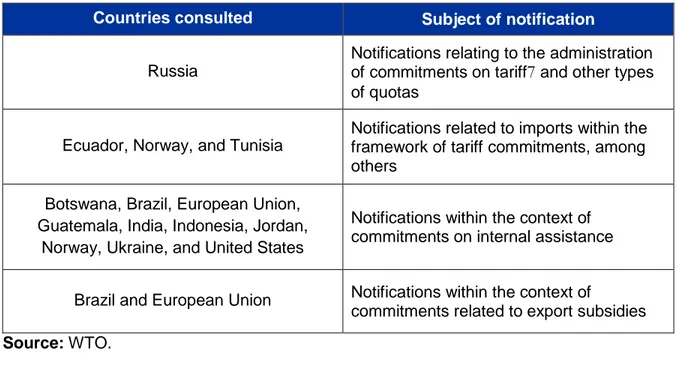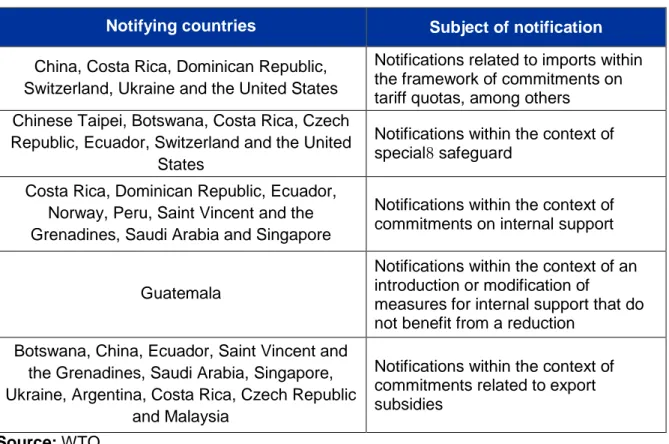Seventy-third Regular Meeting of the Committee on Agriculture
of the World Trade Organization
The Agriculture Committee of the World Trade Organization (WTO) held its seventy-third1
regular meeting in Geneva, Switzerland. The Agribusiness and Commercialization Program of the Inter-American Institute for Cooperation on Agriculture (IICA) has prepared this note2 to provide interested parties with information on the topics discussed at this meeting.
During the first part of the meeting, notifications3 on agriculture presented by various members to the Secretariat of the WTO were examined, in compliance with the principle of transparency that governs the members of the Organization. In the second part of the meeting, other topics relating to the work of the Committee were addressed, including compliance with the commitments undertaken at the Bali Ministerial Conference and the updating of the 1995 list of “major exporters.”
Topics discussed
During the two phases of the meeting (process of examination and analysis of other matters within the mandate of the Committee), the main topics discussed were the following:
A. First phase: process of examination
1. Issues related to compliance with commitments undertaken within the framework of the Program for Reform of the Uruguay Round
Ten countries were consulted regarding their action with respect to the commitments undertaken under the Program and the measures notified prior to the date of convening of the meeting, as presented in Table 1:
1 The event took place on March 21, 2014. 2
Prepared by Adriana Campos Azofeifa, Specialist in Trade Policies and Negotiations, and Coordinator of the WTO Reference Center at IICA, and by Nadia Monge Hernández, Technical Assistant of the WTO Reference Center at IICA. June, 2014. San José, Costa Rica.
3
There are 12 different applicable obligations for notification with respect to agriculture that cover five areas: i) access to markets; ii) internal support; iii) export subsidies; iv) embargos on or restrictions to exports; and v) follow-up to the Marrakech Decision on Net Importing Developing Countries of Food Products. Each Member of the WTO has different notification obligations, based on the specific commitments that it has made under the Agreement on Agriculture. However, some notification obligations, especially with respect to grants for
Table1. Topics consulted with respect to compliance with commitments
Countries consulting Country consulted Topic of notification
United States Brazil Internal support program4
United States Canada Modifications of the customs
tariff proposed by Canada. United States and New
Zealand Canada
Canadian policies with respect to dairy products.
United States China Internal assistance from China
to the cotton industry.
Canada and United States Costa Rica
Fulfillment by Costa Rica of its commitments with regard to the aggregate measurement of support5
United States Ecuador Provision for buying local
products in Ecuador.
Pakistan India Support for prices on the rice
market.
United States India Draft legislation by India on
national food security. Australia, Brazil, Colombia,
and the European Union India
Grants by India for sugar exports.
Canada and United States India Supplies and exports of wheat
from India.
United States Saint Lucia
Provision for buying local products in Saint Lucia for domestic poultry and pork.
Canada and United States Thailand Thai plan to offer guarantees
for paddy rice (de-husked rice)
European Union Turkey Internal support and export
subsidies6 by Turkey
United States Turkey Sales destination for wheat
flour from Turkey
Indonesia United States United States Agricultural Law
Source: WTO
4
In agriculture, any internal grant or other measure that maintains the prices of the producer at a level higher than that of the international market. For example, the direct payments that the Government makes in order to encourage the production or the measures that tend to reduce the cost of the inputs and the marketing in exclusive benefit of the agricultural producers. The Agreement on Agriculture distinguishes two categories of internal support: i) assistance that does not cause any distortion in trade or has minimum effect and ii) which causes distortions in trade.
5
The aggregate measure of support (AMS) is the indicator by which internal support is regulated, according to the Agreement on Agriculture of the Uruguay Round. Internal support relates to benefits that the governments grant to certain productive sectors. The AMS is determined by the estimate of the support market price for each material of production that benefits from assistance, in addition to non-exempt direct payments or any other grant that is not exempted from the reduction commitments.
6
Economic advantage that a Government gives directly or indirectly to the producers of certain goods or services in order to improve their competitive position. There are economic support measures that are prohibited because they distort trade (subsidies to export and grants for local inputs) and others subject to reduction commitments. A subsidy can cause damage, although it is permitted. By “distortion” we mean a situation in which prices and production reach higher or lower levels than those that would normally exist in a competitive market.
In total, 15 notifications were presented with regard to agriculture, of which 47% was presented by six member countries of IICA. This is an indication that the countries of the hemisphere are abiding by the principle of transparency of the WTO in reporting on their progress with respect to their commitments under the Agreement on Agriculture.
Most of the measures raised by the countries of the Americas have to do with internal support. The others are related to customs duties or measures for particular products such as dairy, domestic poultry, pork and wheat flour.
2. Issues relating to notifications dealt with at previous meetings
The procedures of the Agriculture Committee enable it to review new topics or raise issues once again relating to consultations on notifications dealt with at other meetings. On this occasion, some issues were related to programs under way that have not been notified, similarities between notifications and measures implemented, among other topics. The following were the notifications:
Table 2. Topics consulted with regard to notifications subject to examination at previous meetings
Countries consulted Subject of notification
Russia
Notifications relating to the administration of commitments on tariff
7
and other types of quotasEcuador, Norway, and Tunisia
Notifications related to imports within the framework of tariff commitments, among others
Botswana, Brazil, European Union, Guatemala, India, Indonesia, Jordan,
Norway, Ukraine, and United States
Notifications within the context of commitments on internal assistance
Brazil and European Union Notifications within the context of
commitments related to export subsidies Source: WTO.
3. Notifications that were not subject to consultations
Among the most recent notifications, there are some that were not subject to observations or queries. Although at this meeting there were no consultations on those notifications, they could be submitted for examination at future meetings of the Committee. These notifications were as follows:
7
When a country determines that only a specific quantity of a good may be imported under a lower tariff. It is possible to continue to import that good, despite having exceeded this quantity, but the importer has to pay a higher rate. This type of quota is permitted by the WTO.
Table 3. Notifications presented that were not subject to consultations
Notifying countries Subject of notification
China, Costa Rica, Dominican Republic, Switzerland, Ukraine and the United States
Notifications related to imports within the framework of commitments on tariff quotas, among others
Chinese Taipei, Botswana, Costa Rica, Czech Republic, Ecuador, Switzerland and the United
States
Notifications within the context of special
8
safeguardCosta Rica, Dominican Republic, Ecuador, Norway, Peru, Saint Vincent and the Grenadines, Saudi Arabia and Singapore
Notifications within the context of commitments on internal support
Guatemala
Notifications within the context of an introduction or modification of
measures for internal support that do not benefit from a reduction
Botswana, China, Ecuador, Saint Vincent and the Grenadines, Saudi Arabia, Singapore, Ukraine, Argentina, Costa Rica, Czech Republic
and Malaysia
Notifications within the context of commitments related to export subsidies
Source: WTO
B. Second phase: other competing issues In this phase, the following matters were discussed:
1. Application of the Bali decisions on agriculture
The Committee has already begun work on the Declaration of the Bali Ministerial Conference on Export Subsidies and Measures of Similar Effects (competing exports). The Committee requested information from some members on their programs and measures in this regard, since it is felt that export subsidies and related policies in agriculture are those that are the most disruptive to trade in the world markets.
The members have strongly reaffirmed their political commitment to “be moderate” with regard to export subsidies, so that they do not exceed the limits established by the WTO disciplines.
Information was also provided on the discussion by members on “administration of tariff quotas”9, a decision that was taken in Bali to prevent governments from converting the distribution of these tariffs into obstacles to trade.
8
According to the WTO definition, this is a corrective emergency mechanism that is used to temporarily impede imports of a product that can cause harm or threat of severe harm to the national production. The producer is given the opportunity to adjust the competitive level of the product or direct his/her efforts toward another sector of production. Specifically, the special safeguard is used for the agricultural sector. It is a temporary increase in an import duty in order to deal with a growth in imports or with a fall in prices, pursuant to the special provisions of the Agreement on Agriculture.
9
Tariff quotas relate to the application of lower import duties to products that are within the quota, than to products outside the quota.
The Cairns Group presented several “unofficial” documents on these topics (export competition and tariffs), which were discussed by the members.
2. Updating of the list of major exporters
The 1995 list of major exporters is a list of WTO member countries that must provide notification of their exports relating to a number of agricultural products defined by the Committee (main trading products). This list is used to determine if the products exported by a member have received concealed grants.
The Chairman of the Committee suggested that countries could voluntarily announce their withdrawal from the list (which implies that they no longer need to give notification of their exports of these products), when they no longer reach the threshold of a 5%10 share of trade in those products. Additionally, countries that reach that percentage could be incorporated into the list and voluntarily provide notification of their exports on the list. There was no objection to this proposal on the part of the delegations.
The Chairman further urged the members to agree on a voluntary and formal solution to this issue, since for quite a long time, the countries have not managed to come to an agreement on the inclusion or exclusion of members, the procedure for including new products and how the notified information should be separated into broad categories of products such as "coarse grains" in their various components (rye, barley, oats, corn, sorghum and other products).
If you wish to obtain more information, please contact Adriana Campos Azofeifa, IICA Specialist in Policies and Trade Negotiations and Coordinator of the WTO Reference Center at IICA, via e-mail adriana.campos@iica.int or telephone (506) 2216-0170; or Nadia Monge Hernández, Technical Assistant at the WTO Reference Center at IICA, via
e-mail nadia.monge@iica.int or telephone (506) 2216-0358.

